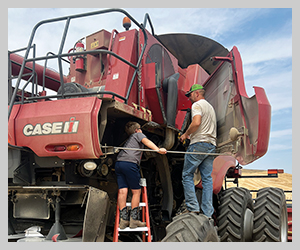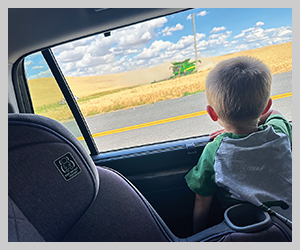
There’s good news for some growers who enrolled in the 2022 Conservation Reserve Program (CRP) general sign-up despite the overall lower rates. The national Farm Service Agency (FSA) office has decided to increase the rates in Asotin and Franklin counties after reviewing data compiled by the state FSA office, the FSA county offices, the Washington Association of Wheat Growers (WAWG) and the National Association of Wheat Growers (NAWG).
Jon Wyss, FSA state executive director, said the rates are still being finalized, but the Franklin County rate will reflect the county office’s proposed rate, while the Asotin County rate will reflect the midpoint between the county office’s proposed rate and the National Agricultural Statistics Service (NASS) rate. Once the new rates are published, the county offices will begin contacting producers who signed up.
“People who didn’t sign up (for CRP), we can’t fix that. It’s not going to reopen the sign-up, it’s just going to say this is the new rate,” Wyss explained. “This shows, the wheels go around, but they don’t change on a dime sometimes. This stuff takes some time to process through. This whole process has shown me that the system works. Those partnerships between all of the producers, all of the county staff, all of the county committee, the state committee staff, the state folks and the associations, those producers and stakeholders and partnerships worked through this issue together.”
According to Wyss, the main reason most of the rates decreased was because NASS moved from a regional model, where data from several counties was averaged, to a local model that better reflects local rates. NASS will no longer be collecting regional data.
What happened?
Almost as soon as the CRP rates for the 2022 general sign-up were published, growers began questioning them. While a few counties (Yakima, Spokane and Lincoln) saw an increase, rates in almost every other Eastern Washington county went down, sometimes by a lot (see chart). Asotin County saw a $57 per acre decrease. Grant County rates went down $38 per acre.
“We began getting calls from growers trying to understand why the rates decreased, sometimes drastically,” said Michelle Hennings, executive director of the Washington Association of Wheat Growers (WAWG). “Growers contacted their county FSA offices, and the process to appeal those rates began. Unfortunately, the national office decided not to accept the rate proposals submitted by the counties.”
At the time, the state FSA office was operating without a state executive director or a fully staffed state committee, but Wyss was adamant that the process went through the proper channels and procedures.
“Whether the state executive director would have been there or the full state committee would have been there, the same procedures would have been followed,” he said. “Producers should be really happy with the local staff. They were very strong advocates on this issue from the county to the county committee to the state, which then went back to national. I’m really proud of the staff for listening to the producers on this. Everything was followed by the book.”
Once the CRP rates are published, they are nonappealable so they don’t influence planting decisions. Wyss was appointed to the state executive director’s position shortly after the rates were published, and he said this was one of the first things waiting for him on his desk. He attended several WAWG board meetings, and each time, he told producers that while he understood their concerns, the deadline to appeal the rates had passed. But behind the scenes, he and other industry stakeholders kept asking questions. The state FSA committee and their Conservation Reserve Enhancement Program partners came up with alternative county rates that considered local cash rent data and neighboring county estimates. NAWG leaders met with FSA administrators to discuss concerns, including this issue. Finally, FSA leadership looked into it, reviewing the data for all the counties in Washington state.
“In order to better understand and review the rental rates for the counties, FSA headquarters had a conversation with program leads. Based on that review and the analysis they conducted, FSA headquarters have said they are going to fix the Franklin County rate and the Asotin County rate for this year,” Wyss said.
Unfortunately, the Grant County rates will remain the same as the national office determined there was enough local data submitted to support the published rates and no adjustment was needed.
About those cash rental rates…
For years, WAWG has maintained that the cash rental rates CRP is based on are flawed when it comes to setting a value for Washington wheat acres. Unlike much of the rest of the country, wheat acres in Washington are generally rented under a crop share agreement, rather than a cash rent. NASS surveys generally don’t account for crop share agreements.
That may be changing. The national FSA office has created a pilot survey that attempts to gather information about crop share rental agreements and is in the process of gathering feedback on those survey questions. While Wyss is hopeful this effort will help address the issue, he cautions that the process may take some time.
“We have a good plan going forward with looking at the survey sample, and then we will continue to sit at the table with stakeholders to get it right,” he said.
WAWG staff and leaders have seen the survey and have provided input on the questions. Hennings said the survey is a big step in the right direction.
“When it comes to crop share and cash rents, we know there is a problem,” she said. “We are working closely with NASS and FSA to resolve the issue. At the same time, farmers still need to fill out the current NASS surveys as completely and accurately as possible so we have confidence that the data these programs rely on is accurate.”
The rental rates aren’t the only issue WAWG would like to see addressed in CRP. As work on the 2023 Farm Bill gears up, WAWG will be focusing on several CRP-related issues, including how the rising cost of inputs are reflected in CRP rental rates, and how environmental benefits are scored for CRP bids.













